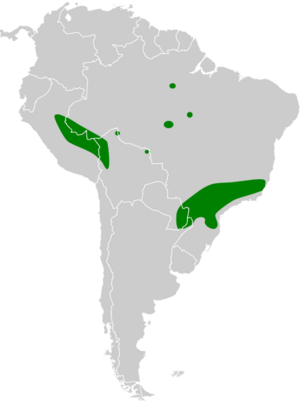Silky-tailed nightjar facts for kids
The silky-tailed nightjar (Antrostomus sericocaudatus) is a type of nightjar bird. These birds belong to the Caprimulgidae family. You can find them in countries like Brazil, Argentina, Bolivia, Paraguay, and Peru. They naturally live in warm, wet lowland forests.
Quick facts for kids Silky-tailed nightjar |
|
|---|---|
 |
|
| Conservation status | |
| Scientific classification | |
| Genus: |
Antrostomus
|
| Species: |
sericocaudatus
|
 |
|
| Synonyms | |
|
Caprimulgus sericocaudatus |
|
Contents
What is a Silky-tailed Nightjar?
Different Types of Silky-tailed Nightjars
The silky-tailed nightjar has two main groups, called subspecies. These are Antrostomus sericocaudatus sericocaudatus and A. s. mengeli. Long ago, other nightjars like the tawny-collared nightjar and Yucatan nightjar were thought to be part of this species too.
How to Identify a Silky-tailed Nightjar
Adult male silky-tailed nightjars have light grey-brown feathers with a strong black stripe on their head and neck. They have blackish whiskers on their face and dark spots with reddish-brown on their sides. A narrow reddish-brown collar is found on the back of their neck.
The feathers on their back, rump, and upper tail are dark brown with irregular patterns of light brown and cinnamon. Their chest is dark brown with short, narrow cinnamon bars. The belly is also dark brown, but it has blotches and irregular narrow bars of light brown.
Where Silky-tailed Nightjars Live
Habitats and Locations
The first subspecies, A. s. sericocaudatus, lives in the Atlantic Forest area of southeastern Brazil, eastern Paraguay, and the very northeastern part of Argentina. They prefer to live inside and at the edges of younger forests and subtropical evergreen forests. These birds can be found at heights between 82 and 913 meters (about 269 to 2,995 feet) above sea level.
The second subspecies, A. s. mengeli, is found in eastern Peru, northwestern Bolivia, and some places in Brazil's Pará state. They live in many different areas, including old tropical forests and lowland tropical rainforests. They can be found at heights between 227 and 1,200 meters (about 745 to 3,937 feet) above sea level.
What Silky-tailed Nightjars Eat
Nightjars eat many different kinds of insects. When they have babies, the parents feed them by bringing up food they have already swallowed. This is called regurgitation. Young birds also look for insects on the ground near their nest. Sometimes, they pick up small bits of soil to help them digest their food.
Silky-tailed Nightjar Reproduction and Behavior
Breeding Season
Silky-tailed nightjars usually breed from August to December. This time includes part of the dry season and the start of the rainy season. Their courtship, which is how they attract a mate, begins in mid-August. Nests are built between early September and mid-November.
Courtship and Nesting Habits
Male nightjars sing more often when they are trying to find a mate. When a female flies in and lands on a branch about 10 meters away, the male changes his song. He sings faster, making several quick notes. As the male flies towards the female, he spreads his tail like a fan and lowers his wings. Then, he mates with the female.
Both parents help take care of the nest. The female usually sits on the eggs during the day, and the male takes over at night.
Protecting Their Young
Nightjars have a clever way to protect their eggs and babies from predators. They pretend to be hurt! This behavior, called injury-feigning, makes predators think the adult bird is an easy target. The predator then follows the "injured" adult away from the nest.
Adult nightjars also quickly fly away when something gets too close to their nest. This is another trick to distract predators. After flying away, they land facing the same direction and parallel to a path. This gives them a clear escape route if a predator follows. When they do these things, the adult birds are hard to see, but their eggs might be visible.
How Silky-tailed Nightjars Communicate
Different Songs of Nightjars
The two subspecies of silky-tailed nightjar have very different songs. The A. s. sericocaudatus sings a short, clear sound that connects two main high notes, like "ree-o-ree." The A. s. mengeli has a more sad, wavy song that sounds like "doh wheo eeo." Both the male and female birds in a pair sing. They usually sing from a low branch or while flying low, mostly at dawn and dusk.
Conservation Status
The IUCN (International Union for Conservation of Nature) says the silky-tailed nightjar is of "Least Concern." This means they are not currently in danger of disappearing. However, we don't know exactly how many there are, and their numbers are thought to be going down. No immediate threats have been found. But because the Atlantic Forest and the Amazon Basin are always being changed by human development, the known groups of Silky-tailed Nightjars might quickly get smaller.


